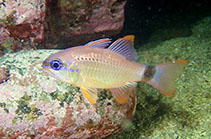| Family: |
Apogonidae (Cardinalfishes), subfamily: Apogoninae |
| Max. size: |
14.2 cm TL (male/unsexed); max.weight: 28.0 g |
| Environment: |
reef-associated; brackish; marine; depth range 1 - 97 m |
| Distribution: |
Indo-West Pacific: Red Sea and Persian Gulf, Gulf of Oman and scattered localities in East Africa, Seychelles, India, Sri Lanka, the Indo-Malayan region, and Hong Kong; south to Australia; east to Fiji. |
| Diagnosis: |
Dorsal spines (total): 8-8; Dorsal soft rays (total): 9-9; Anal spines: 2-2; Anal soft rays: 8-8; Vertebrae: 24-24. This species is distinguished by the following characters: D VII+I,9; A II,8-9; greatest body depth 2.5-2.9 SL; head and body with ctenoid scales; preopercle ridge is smooth, edges serrate; no supramaxilla; with basisphenoid; a pair of reduced uroneurals present or absent; epurals 3; free hypurals 5; parhypural are separate; forked caudal fin; head and/or body with one or more light or dark stripes (Ref. 96888). Colour of body mauve on upper back, grading to yellow orange on sides with pair of blue stripes on snout continuing through eye; dark spots along lateral line; caudal fin base with a distinct black bar or large round spot (Ref. 90102). |
| Biology: |
Common in shallow coastal reefs with moderate currents (Ref. 48636). Also in tidal channels of estuaries (Ref. 48636). Adults usually in small schools comprising pairs (Ref. 48636). |
| IUCN Red List Status: |
Least Concern (LC); Date assessed: 04 February 2009 Ref. (130435)
|
| Threat to humans: |
harmless |
Source and more info: www.fishbase.org. For personal, classroom, and other internal use only. Not for publication.

